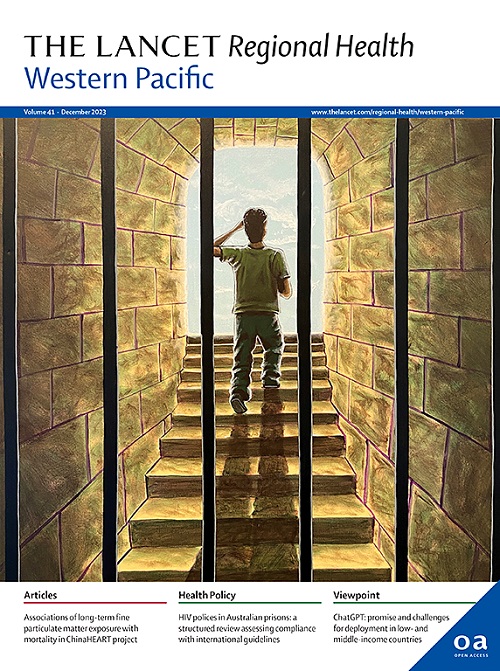Capturing the complete clinical spectrum and incidence of severe acute Group A Streptococcus (GAS) disease: a population-based study in Auckland, New Zealand
IF 7.6
1区 医学
Q1 HEALTH CARE SCIENCES & SERVICES
引用次数: 0
Abstract
Background
The global health burden of Streptococcus pyogenes (Group A Streptococcus, GAS) disease has led the World Health Organization to declare GAS vaccine development an international priority. Severe acute GAS disease comprises hospitalised infections, toxin-mediated disease (scarlet fever and streptococcal toxic shock syndrome) and immune-mediated disease (acute rheumatic fever [ARF] and acute post-streptococcal glomerulonephritis). This study aimed to characterize the burden and spectrum of severe acute GAS disease in Auckland, New Zealand, to inform future GAS vaccine studies in this setting.
Methods
This prospective population-based multicentre cross-sectional observational study utilized laboratory data and ARF notifications to capture all hospitalised GAS infections and toxin- and immune-mediated disease cases associated with hospitalisation in Auckland during 2023. The epidemiology, clinical features, incidence and hospitalisation costs of these cases are described.
Findings
The complete clinical spectrum of severe acute GAS disease was observed, with 606 cases captured corresponding to 1:2000 people affected each year (52 cases/100,000 population/year). The burden is inequitably distributed across the population, greatest at the intersection of age, ethnicity and socioeconomic deprivation. In the most deprived areas, approximately 1:400 Pacific children <10-years and 1:200 Pacific adults ≥80-years are affected annually (261 and 483 cases/100,000 population/year, respectively). Direct hospitalisation costs exceeded $13·2 million New Zealand dollars.
Interpretation
This study demonstrates that the complete clinical spectrum of severe acute GAS disease occurs in Auckland and is associated with a substantial health and economic burden. The high incidence and entire range of severe acute GAS disease present make Auckland an ideal location for future vaccine studies.
Funding
Ministry of Health New Zealand, Health Research Council of New Zealand (HRC-NZ), Royal College of Pathologists of Australasia (RCPA) Foundation.
捕获严重急性A群链球菌(GAS)疾病的完整临床谱和发病率:新西兰奥克兰的一项基于人群的研究
化脓性链球菌(A群链球菌,GAS)疾病的全球健康负担导致世界卫生组织宣布开发GAS疫苗为国际优先事项。严重急性气体中毒疾病包括住院感染、毒素介导的疾病(猩红热和链球菌中毒性休克综合征)和免疫介导的疾病(急性风湿热和急性链球菌感染后肾小球肾炎)。本研究旨在描述新西兰奥克兰严重急性气体疾病的负担和频谱,为未来在此背景下进行气体疫苗研究提供信息。方法:这项基于人群的前瞻性多中心横断面观察性研究利用实验室数据和ARF报告来捕获2023年期间奥克兰所有住院的GAS感染以及与住院相关的毒素和免疫介导性疾病病例。描述了这些病例的流行病学、临床特征、发病率和住院费用。结果观察到严重急性GAS病的完整临床谱,每年捕获606例,对应1:2000患者(52例/10万人/年)。这种负担在人口中分配不均,在年龄、种族和社会经济贫困的交叉点上负担最重。在最贫困地区,每年约有1:40 00的太平洋地区10岁以上儿童和1:20 00的太平洋地区≥80岁的成年人受到影响(分别为261和483例/10万人/年)。直接住院费用超过1 320万新西兰元。本研究表明,严重急性气体疾病的完整临床谱发生在奥克兰,并与巨大的健康和经济负担有关。目前严重急性气体疾病的高发病率和全范围使奥克兰成为未来疫苗研究的理想地点。新西兰卫生部、新西兰卫生研究理事会(HRC-NZ)、澳大拉西亚皇家病理学家学院(RCPA)基金会。
本文章由计算机程序翻译,如有差异,请以英文原文为准。
求助全文
约1分钟内获得全文
求助全文
来源期刊

The Lancet Regional Health: Western Pacific
Medicine-Pediatrics, Perinatology and Child Health
CiteScore
8.80
自引率
2.80%
发文量
305
审稿时长
11 weeks
期刊介绍:
The Lancet Regional Health – Western Pacific, a gold open access journal, is an integral part of The Lancet's global initiative advocating for healthcare quality and access worldwide. It aims to advance clinical practice and health policy in the Western Pacific region, contributing to enhanced health outcomes. The journal publishes high-quality original research shedding light on clinical practice and health policy in the region. It also includes reviews, commentaries, and opinion pieces covering diverse regional health topics, such as infectious diseases, non-communicable diseases, child and adolescent health, maternal and reproductive health, aging health, mental health, the health workforce and systems, and health policy.
 求助内容:
求助内容: 应助结果提醒方式:
应助结果提醒方式:


